Exploring Audience Engagement and Emotional Connection in Film
VerifiedAdded on 2022/09/09
|18
|4382
|14
Report
AI Summary
This report examines the crucial role of emotional connection in movie making and audience engagement. It begins by defining audience engagement and emphasizing the importance of emotion as a key element in captivating viewers. The report delves into the theoretical background, exploring how filmmakers use emotion to appeal to audiences, and discusses various theories such as mood management, affective disposition, excitation transfer, sensation seeking, and meta-emotion. A literature review highlights the significance of actor emotional development and change in creating audience attachment. The methodology section outlines the use of elements like visual imagery, pathos, life experience, empathy, and sympathy to connect with viewers on a personal level. Pathos, empathy, and sympathy are explored in detail, as well as the influence of life experiences on movie creation. The report concludes by emphasizing the importance of emotional engagement in creating a connection with the audience.
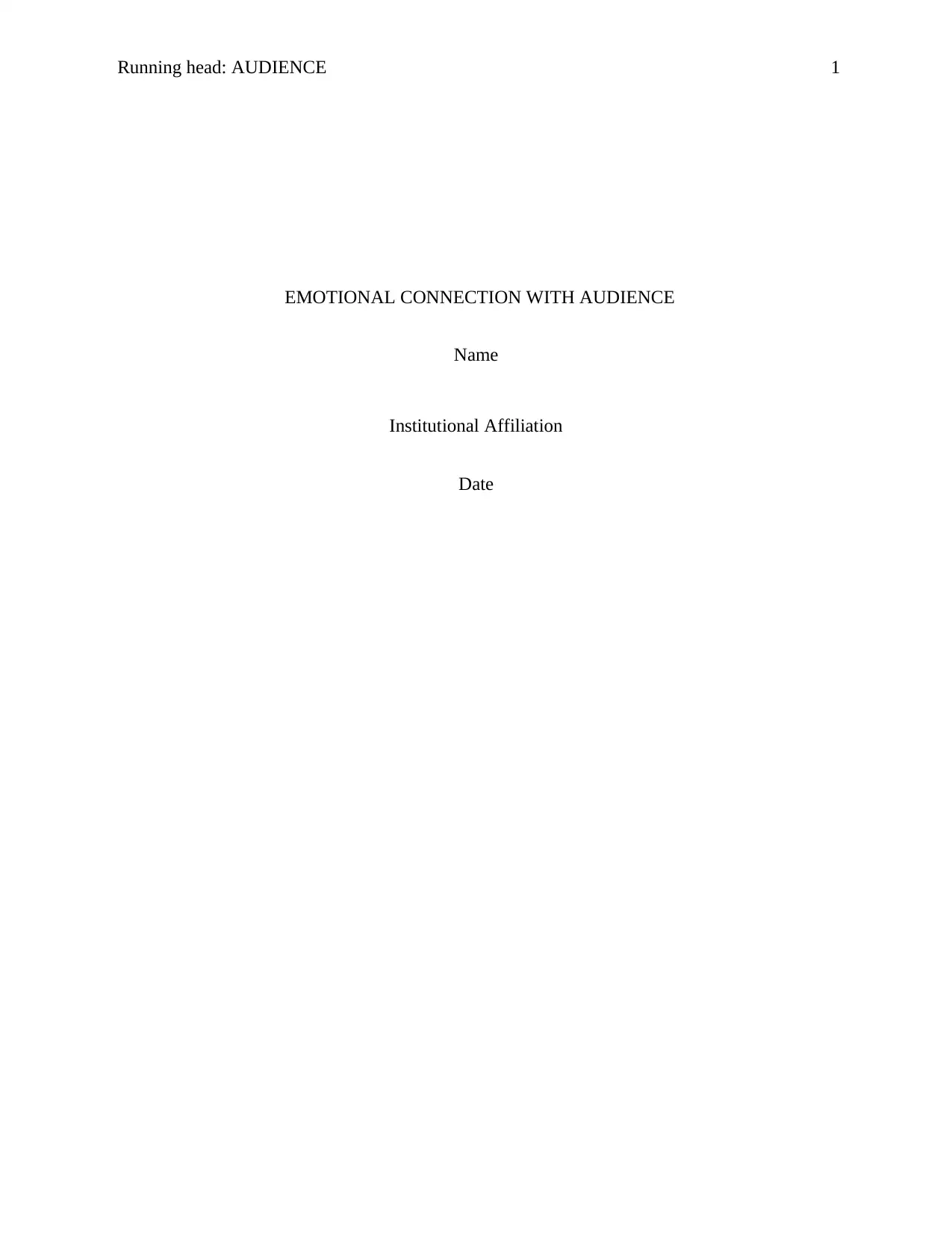
Running head: AUDIENCE 1
EMOTIONAL CONNECTION WITH AUDIENCE
Name
Institutional Affiliation
Date
EMOTIONAL CONNECTION WITH AUDIENCE
Name
Institutional Affiliation
Date
Paraphrase This Document
Need a fresh take? Get an instant paraphrase of this document with our AI Paraphraser
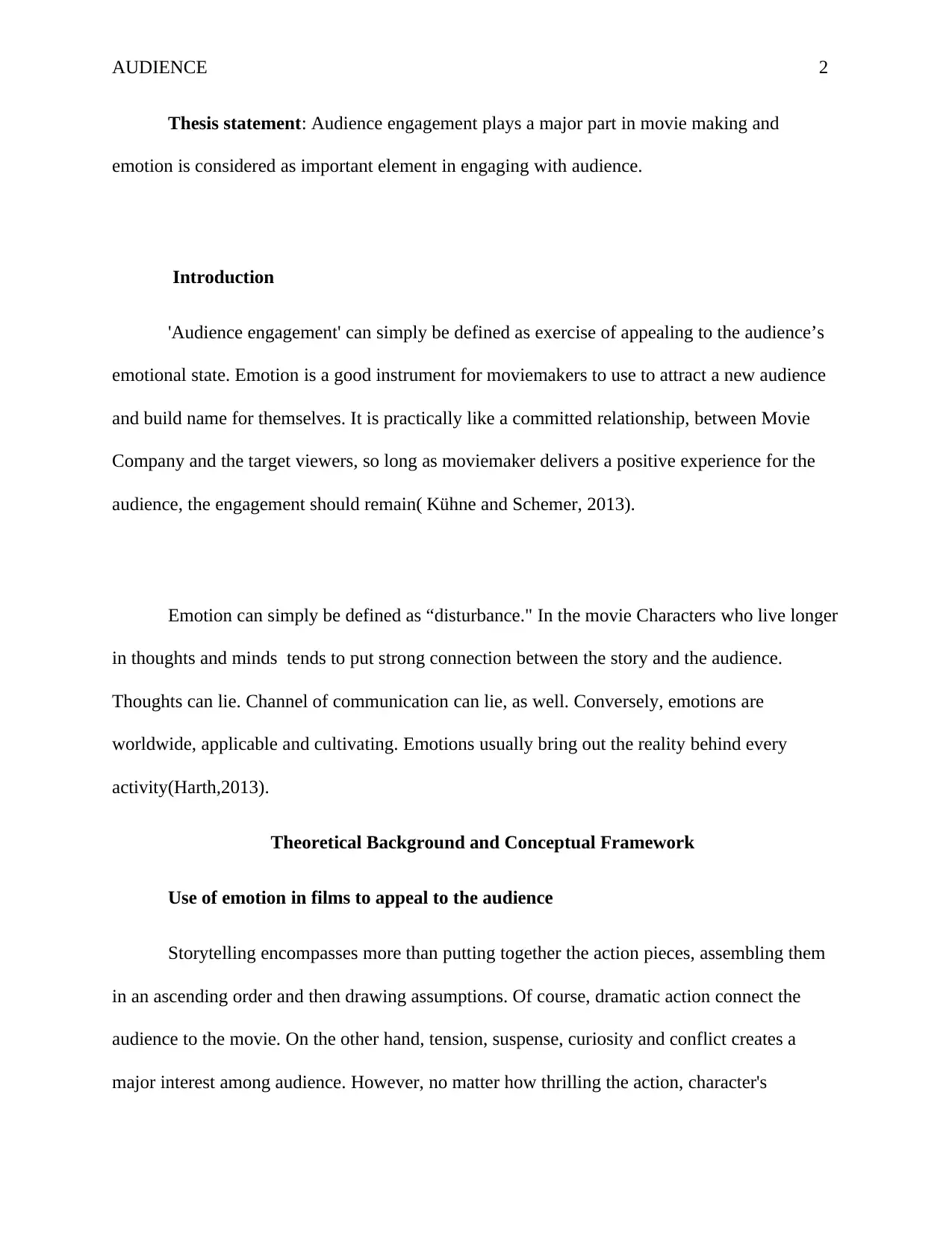
AUDIENCE 2
Thesis statement: Audience engagement plays a major part in movie making and
emotion is considered as important element in engaging with audience.
Introduction
'Audience engagement' can simply be defined as exercise of appealing to the audience’s
emotional state. Emotion is a good instrument for moviemakers to use to attract a new audience
and build name for themselves. It is practically like a committed relationship, between Movie
Company and the target viewers, so long as moviemaker delivers a positive experience for the
audience, the engagement should remain( Kühne and Schemer, 2013).
Emotion can simply be defined as “disturbance." In the movie Characters who live longer
in thoughts and minds tends to put strong connection between the story and the audience.
Thoughts can lie. Channel of communication can lie, as well. Conversely, emotions are
worldwide, applicable and cultivating. Emotions usually bring out the reality behind every
activity(Harth,2013).
Theoretical Background and Conceptual Framework
Use of emotion in films to appeal to the audience
Storytelling encompasses more than putting together the action pieces, assembling them
in an ascending order and then drawing assumptions. Of course, dramatic action connect the
audience to the movie. On the other hand, tension, suspense, curiosity and conflict creates a
major interest among audience. However, no matter how thrilling the action, character's
Thesis statement: Audience engagement plays a major part in movie making and
emotion is considered as important element in engaging with audience.
Introduction
'Audience engagement' can simply be defined as exercise of appealing to the audience’s
emotional state. Emotion is a good instrument for moviemakers to use to attract a new audience
and build name for themselves. It is practically like a committed relationship, between Movie
Company and the target viewers, so long as moviemaker delivers a positive experience for the
audience, the engagement should remain( Kühne and Schemer, 2013).
Emotion can simply be defined as “disturbance." In the movie Characters who live longer
in thoughts and minds tends to put strong connection between the story and the audience.
Thoughts can lie. Channel of communication can lie, as well. Conversely, emotions are
worldwide, applicable and cultivating. Emotions usually bring out the reality behind every
activity(Harth,2013).
Theoretical Background and Conceptual Framework
Use of emotion in films to appeal to the audience
Storytelling encompasses more than putting together the action pieces, assembling them
in an ascending order and then drawing assumptions. Of course, dramatic action connect the
audience to the movie. On the other hand, tension, suspense, curiosity and conflict creates a
major interest among audience. However, no matter how thrilling the action, character's
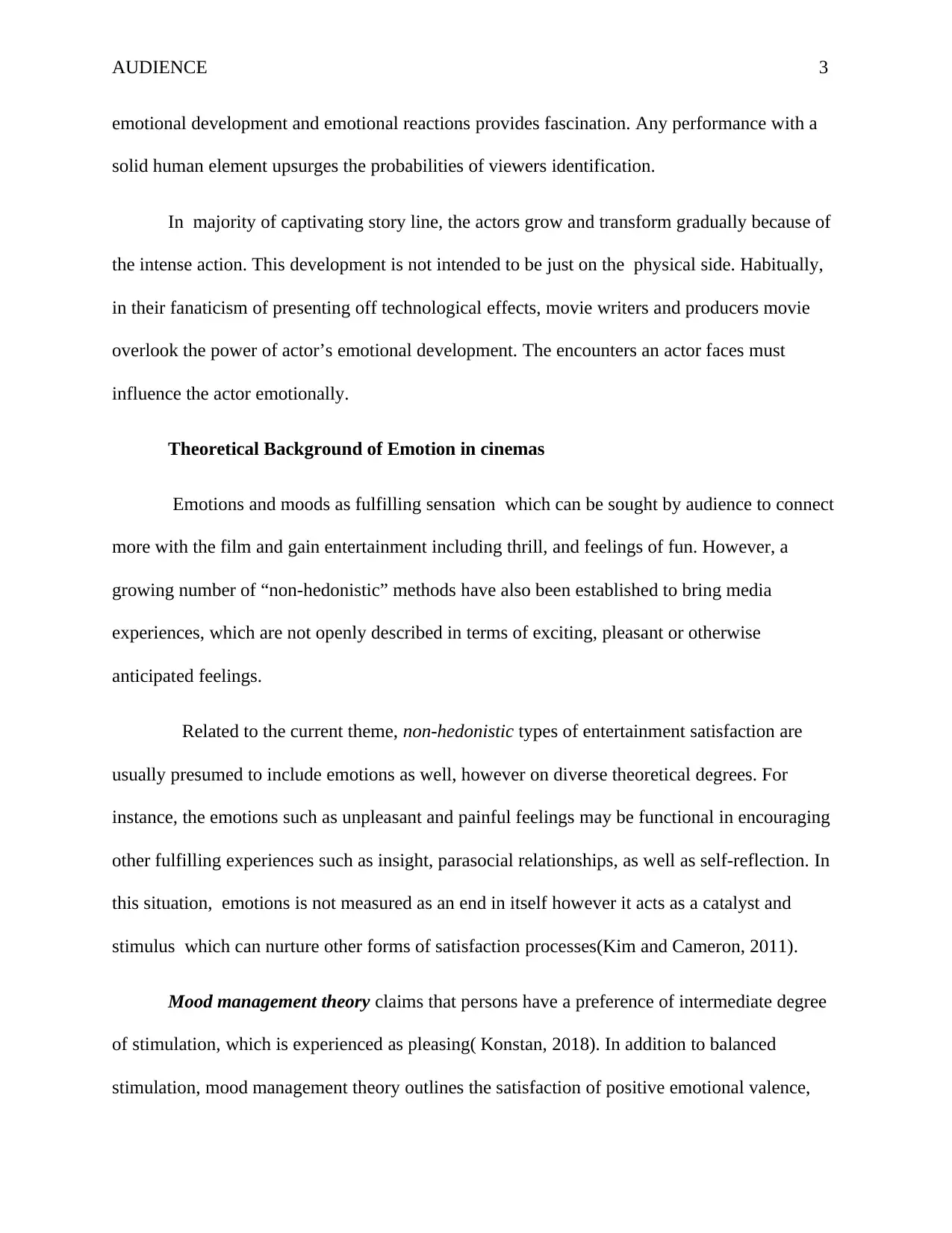
AUDIENCE 3
emotional development and emotional reactions provides fascination. Any performance with a
solid human element upsurges the probabilities of viewers identification.
In majority of captivating story line, the actors grow and transform gradually because of
the intense action. This development is not intended to be just on the physical side. Habitually,
in their fanaticism of presenting off technological effects, movie writers and producers movie
overlook the power of actor’s emotional development. The encounters an actor faces must
influence the actor emotionally.
Theoretical Background of Emotion in cinemas
Emotions and moods as fulfilling sensation which can be sought by audience to connect
more with the film and gain entertainment including thrill, and feelings of fun. However, a
growing number of “non-hedonistic” methods have also been established to bring media
experiences, which are not openly described in terms of exciting, pleasant or otherwise
anticipated feelings.
Related to the current theme, non-hedonistic types of entertainment satisfaction are
usually presumed to include emotions as well, however on diverse theoretical degrees. For
instance, the emotions such as unpleasant and painful feelings may be functional in encouraging
other fulfilling experiences such as insight, parasocial relationships, as well as self-reflection. In
this situation, emotions is not measured as an end in itself however it acts as a catalyst and
stimulus which can nurture other forms of satisfaction processes(Kim and Cameron, 2011).
Mood management theory claims that persons have a preference of intermediate degree
of stimulation, which is experienced as pleasing( Konstan, 2018). In addition to balanced
stimulation, mood management theory outlines the satisfaction of positive emotional valence,
emotional development and emotional reactions provides fascination. Any performance with a
solid human element upsurges the probabilities of viewers identification.
In majority of captivating story line, the actors grow and transform gradually because of
the intense action. This development is not intended to be just on the physical side. Habitually,
in their fanaticism of presenting off technological effects, movie writers and producers movie
overlook the power of actor’s emotional development. The encounters an actor faces must
influence the actor emotionally.
Theoretical Background of Emotion in cinemas
Emotions and moods as fulfilling sensation which can be sought by audience to connect
more with the film and gain entertainment including thrill, and feelings of fun. However, a
growing number of “non-hedonistic” methods have also been established to bring media
experiences, which are not openly described in terms of exciting, pleasant or otherwise
anticipated feelings.
Related to the current theme, non-hedonistic types of entertainment satisfaction are
usually presumed to include emotions as well, however on diverse theoretical degrees. For
instance, the emotions such as unpleasant and painful feelings may be functional in encouraging
other fulfilling experiences such as insight, parasocial relationships, as well as self-reflection. In
this situation, emotions is not measured as an end in itself however it acts as a catalyst and
stimulus which can nurture other forms of satisfaction processes(Kim and Cameron, 2011).
Mood management theory claims that persons have a preference of intermediate degree
of stimulation, which is experienced as pleasing( Konstan, 2018). In addition to balanced
stimulation, mood management theory outlines the satisfaction of positive emotional valence,
⊘ This is a preview!⊘
Do you want full access?
Subscribe today to unlock all pages.

Trusted by 1+ million students worldwide
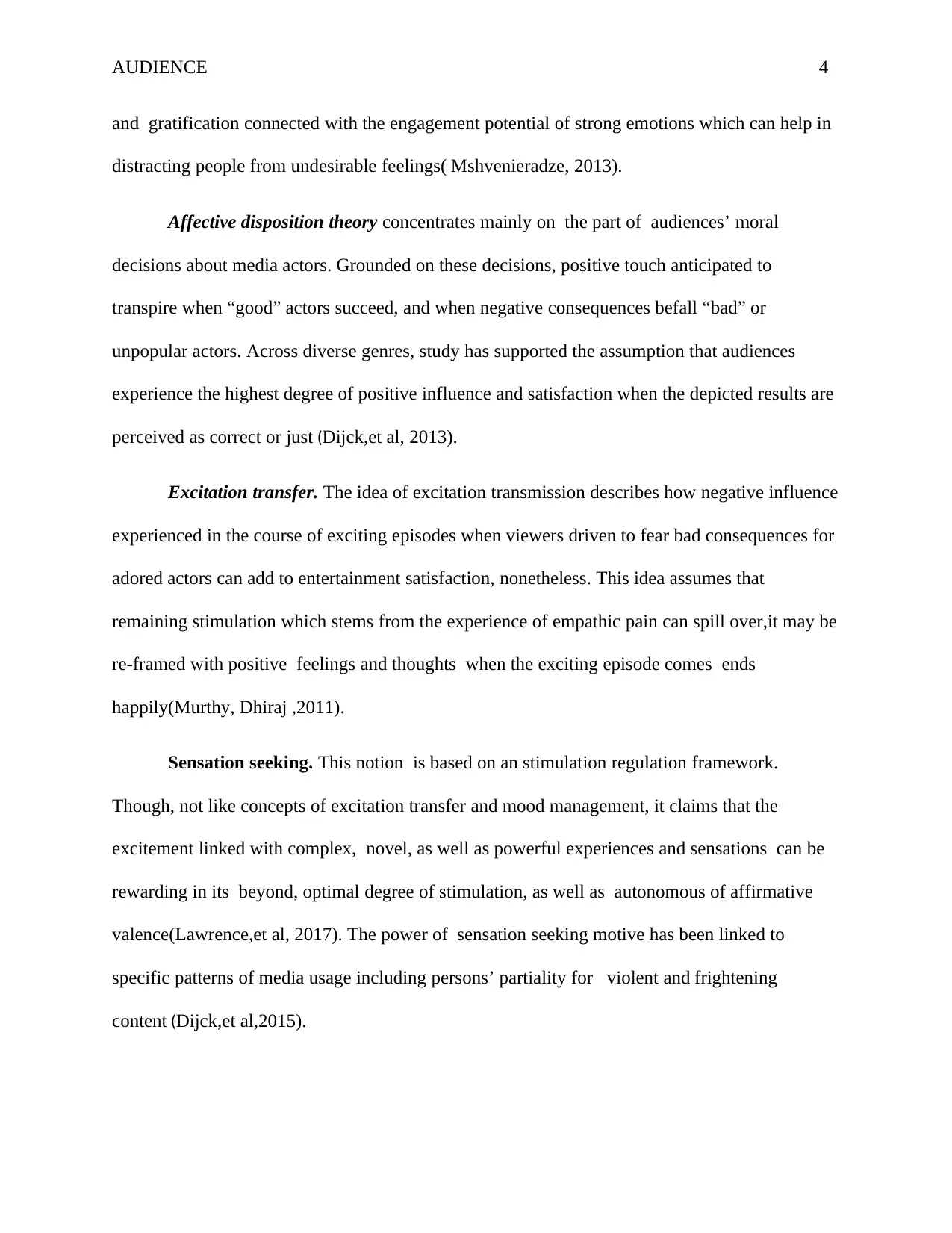
AUDIENCE 4
and gratification connected with the engagement potential of strong emotions which can help in
distracting people from undesirable feelings( Mshvenieradze, 2013).
Affective disposition theory concentrates mainly on the part of audiences’ moral
decisions about media actors. Grounded on these decisions, positive touch anticipated to
transpire when “good” actors succeed, and when negative consequences befall “bad” or
unpopular actors. Across diverse genres, study has supported the assumption that audiences
experience the highest degree of positive influence and satisfaction when the depicted results are
perceived as correct or just (Dijck,et al, 2013).
Excitation transfer. The idea of excitation transmission describes how negative influence
experienced in the course of exciting episodes when viewers driven to fear bad consequences for
adored actors can add to entertainment satisfaction, nonetheless. This idea assumes that
remaining stimulation which stems from the experience of empathic pain can spill over,it may be
re-framed with positive feelings and thoughts when the exciting episode comes ends
happily(Murthy, Dhiraj ,2011).
Sensation seeking. This notion is based on an stimulation regulation framework.
Though, not like concepts of excitation transfer and mood management, it claims that the
excitement linked with complex, novel, as well as powerful experiences and sensations can be
rewarding in its beyond, optimal degree of stimulation, as well as autonomous of affirmative
valence(Lawrence,et al, 2017). The power of sensation seeking motive has been linked to
specific patterns of media usage including persons’ partiality for violent and frightening
content (Dijck,et al,2015).
and gratification connected with the engagement potential of strong emotions which can help in
distracting people from undesirable feelings( Mshvenieradze, 2013).
Affective disposition theory concentrates mainly on the part of audiences’ moral
decisions about media actors. Grounded on these decisions, positive touch anticipated to
transpire when “good” actors succeed, and when negative consequences befall “bad” or
unpopular actors. Across diverse genres, study has supported the assumption that audiences
experience the highest degree of positive influence and satisfaction when the depicted results are
perceived as correct or just (Dijck,et al, 2013).
Excitation transfer. The idea of excitation transmission describes how negative influence
experienced in the course of exciting episodes when viewers driven to fear bad consequences for
adored actors can add to entertainment satisfaction, nonetheless. This idea assumes that
remaining stimulation which stems from the experience of empathic pain can spill over,it may be
re-framed with positive feelings and thoughts when the exciting episode comes ends
happily(Murthy, Dhiraj ,2011).
Sensation seeking. This notion is based on an stimulation regulation framework.
Though, not like concepts of excitation transfer and mood management, it claims that the
excitement linked with complex, novel, as well as powerful experiences and sensations can be
rewarding in its beyond, optimal degree of stimulation, as well as autonomous of affirmative
valence(Lawrence,et al, 2017). The power of sensation seeking motive has been linked to
specific patterns of media usage including persons’ partiality for violent and frightening
content (Dijck,et al,2015).
Paraphrase This Document
Need a fresh take? Get an instant paraphrase of this document with our AI Paraphraser
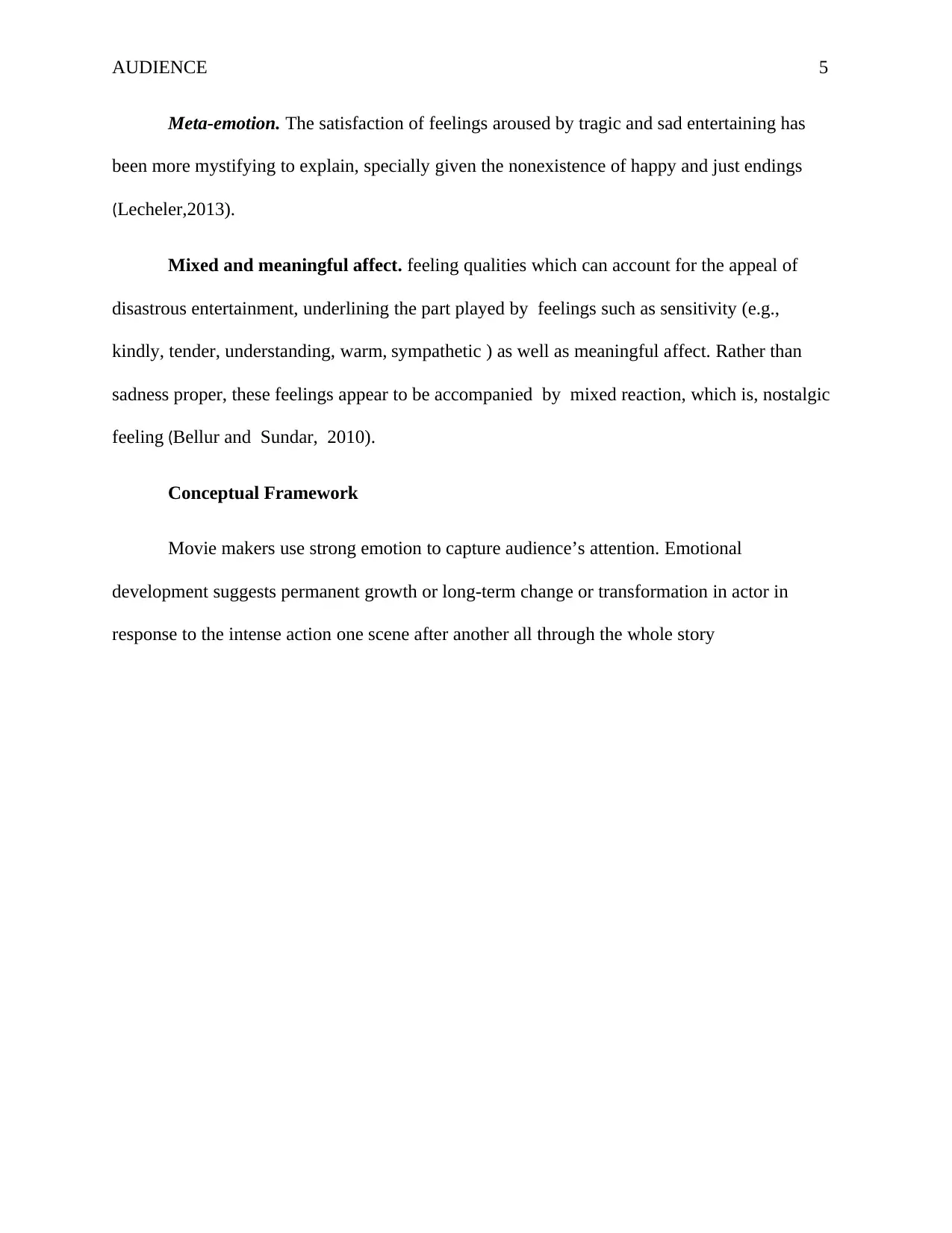
AUDIENCE 5
Meta-emotion. The satisfaction of feelings aroused by tragic and sad entertaining has
been more mystifying to explain, specially given the nonexistence of happy and just endings
(Lecheler,2013).
Mixed and meaningful affect. feeling qualities which can account for the appeal of
disastrous entertainment, underlining the part played by feelings such as sensitivity (e.g.,
kindly, tender, understanding, warm, sympathetic ) as well as meaningful affect. Rather than
sadness proper, these feelings appear to be accompanied by mixed reaction, which is, nostalgic
feeling (Bellur and Sundar, 2010).
Conceptual Framework
Movie makers use strong emotion to capture audience’s attention. Emotional
development suggests permanent growth or long-term change or transformation in actor in
response to the intense action one scene after another all through the whole story
Meta-emotion. The satisfaction of feelings aroused by tragic and sad entertaining has
been more mystifying to explain, specially given the nonexistence of happy and just endings
(Lecheler,2013).
Mixed and meaningful affect. feeling qualities which can account for the appeal of
disastrous entertainment, underlining the part played by feelings such as sensitivity (e.g.,
kindly, tender, understanding, warm, sympathetic ) as well as meaningful affect. Rather than
sadness proper, these feelings appear to be accompanied by mixed reaction, which is, nostalgic
feeling (Bellur and Sundar, 2010).
Conceptual Framework
Movie makers use strong emotion to capture audience’s attention. Emotional
development suggests permanent growth or long-term change or transformation in actor in
response to the intense action one scene after another all through the whole story
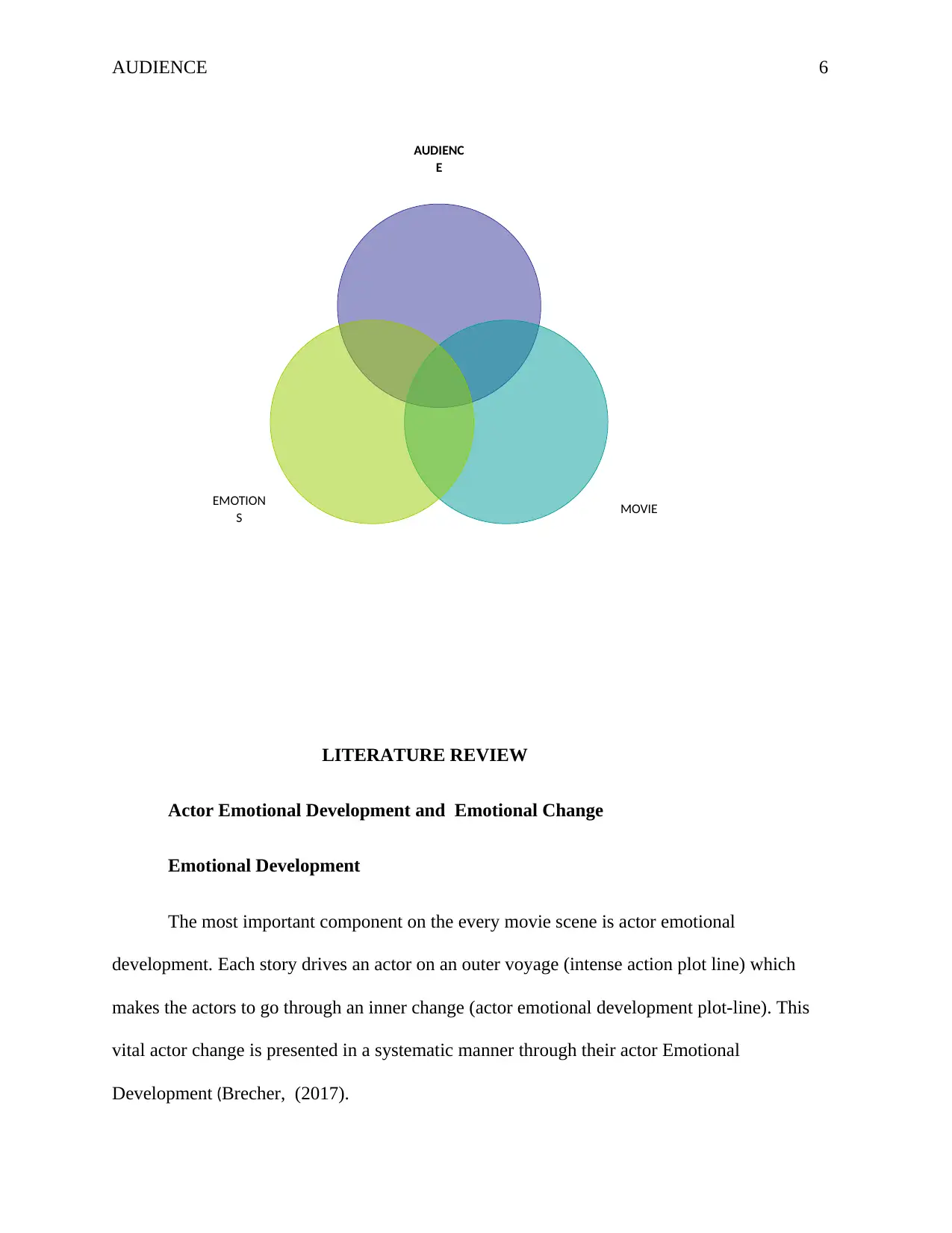
AUDIENCE 6
LITERATURE REVIEW
Actor Emotional Development and Emotional Change
Emotional Development
The most important component on the every movie scene is actor emotional
development. Each story drives an actor on an outer voyage (intense action plot line) which
makes the actors to go through an inner change (actor emotional development plot-line). This
vital actor change is presented in a systematic manner through their actor Emotional
Development (Brecher, (2017).
AUDIENC
E
MOVIE
EMOTION
S
LITERATURE REVIEW
Actor Emotional Development and Emotional Change
Emotional Development
The most important component on the every movie scene is actor emotional
development. Each story drives an actor on an outer voyage (intense action plot line) which
makes the actors to go through an inner change (actor emotional development plot-line). This
vital actor change is presented in a systematic manner through their actor Emotional
Development (Brecher, (2017).
AUDIENC
E
MOVIE
EMOTION
S
⊘ This is a preview!⊘
Do you want full access?
Subscribe today to unlock all pages.

Trusted by 1+ million students worldwide
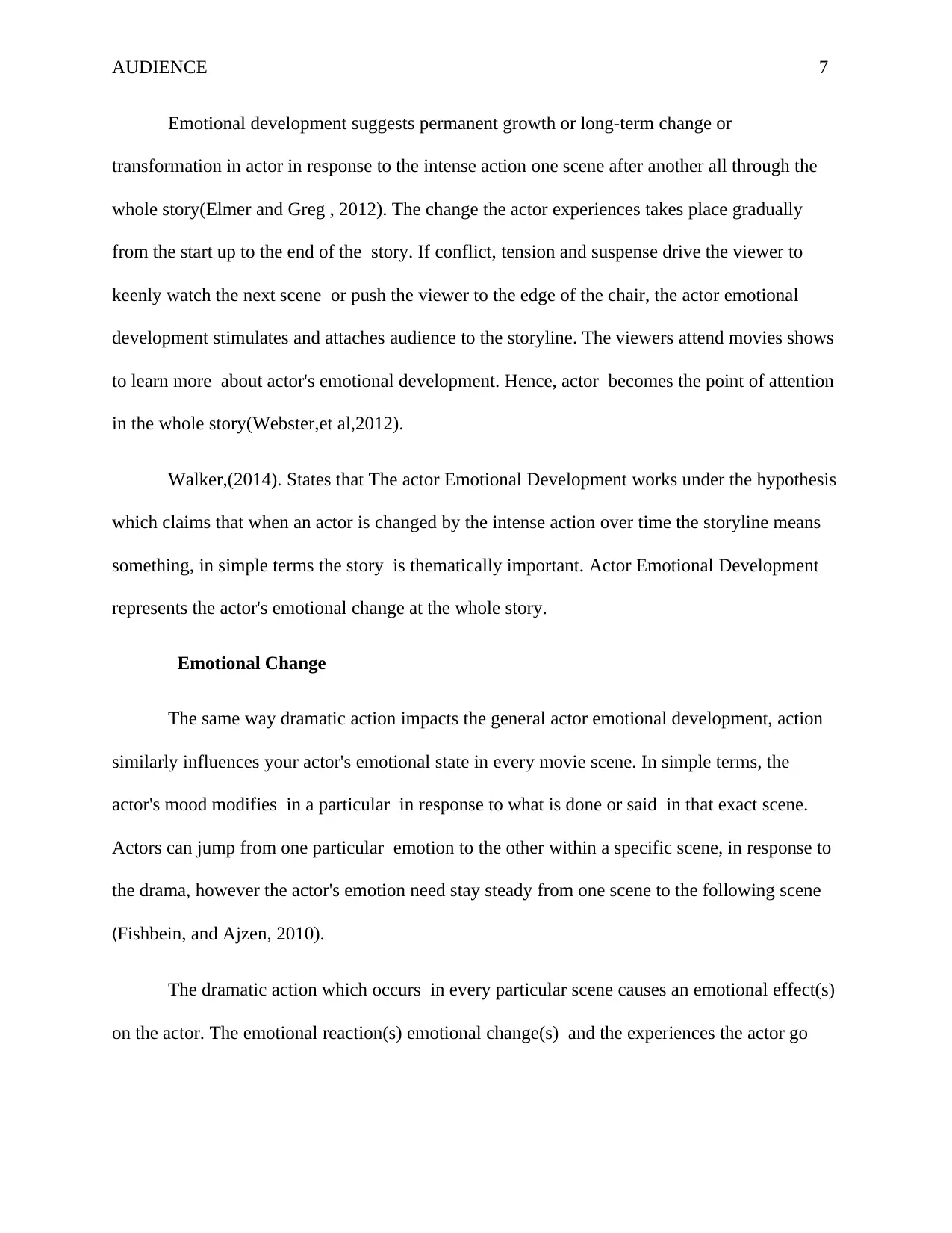
AUDIENCE 7
Emotional development suggests permanent growth or long-term change or
transformation in actor in response to the intense action one scene after another all through the
whole story(Elmer and Greg , 2012). The change the actor experiences takes place gradually
from the start up to the end of the story. If conflict, tension and suspense drive the viewer to
keenly watch the next scene or push the viewer to the edge of the chair, the actor emotional
development stimulates and attaches audience to the storyline. The viewers attend movies shows
to learn more about actor's emotional development. Hence, actor becomes the point of attention
in the whole story(Webster,et al,2012).
Walker,(2014). States that The actor Emotional Development works under the hypothesis
which claims that when an actor is changed by the intense action over time the storyline means
something, in simple terms the story is thematically important. Actor Emotional Development
represents the actor's emotional change at the whole story.
Emotional Change
The same way dramatic action impacts the general actor emotional development, action
similarly influences your actor's emotional state in every movie scene. In simple terms, the
actor's mood modifies in a particular in response to what is done or said in that exact scene.
Actors can jump from one particular emotion to the other within a specific scene, in response to
the drama, however the actor's emotion need stay steady from one scene to the following scene
(Fishbein, and Ajzen, 2010).
The dramatic action which occurs in every particular scene causes an emotional effect(s)
on the actor. The emotional reaction(s) emotional change(s) and the experiences the actor go
Emotional development suggests permanent growth or long-term change or
transformation in actor in response to the intense action one scene after another all through the
whole story(Elmer and Greg , 2012). The change the actor experiences takes place gradually
from the start up to the end of the story. If conflict, tension and suspense drive the viewer to
keenly watch the next scene or push the viewer to the edge of the chair, the actor emotional
development stimulates and attaches audience to the storyline. The viewers attend movies shows
to learn more about actor's emotional development. Hence, actor becomes the point of attention
in the whole story(Webster,et al,2012).
Walker,(2014). States that The actor Emotional Development works under the hypothesis
which claims that when an actor is changed by the intense action over time the storyline means
something, in simple terms the story is thematically important. Actor Emotional Development
represents the actor's emotional change at the whole story.
Emotional Change
The same way dramatic action impacts the general actor emotional development, action
similarly influences your actor's emotional state in every movie scene. In simple terms, the
actor's mood modifies in a particular in response to what is done or said in that exact scene.
Actors can jump from one particular emotion to the other within a specific scene, in response to
the drama, however the actor's emotion need stay steady from one scene to the following scene
(Fishbein, and Ajzen, 2010).
The dramatic action which occurs in every particular scene causes an emotional effect(s)
on the actor. The emotional reaction(s) emotional change(s) and the experiences the actor go
Paraphrase This Document
Need a fresh take? Get an instant paraphrase of this document with our AI Paraphraser
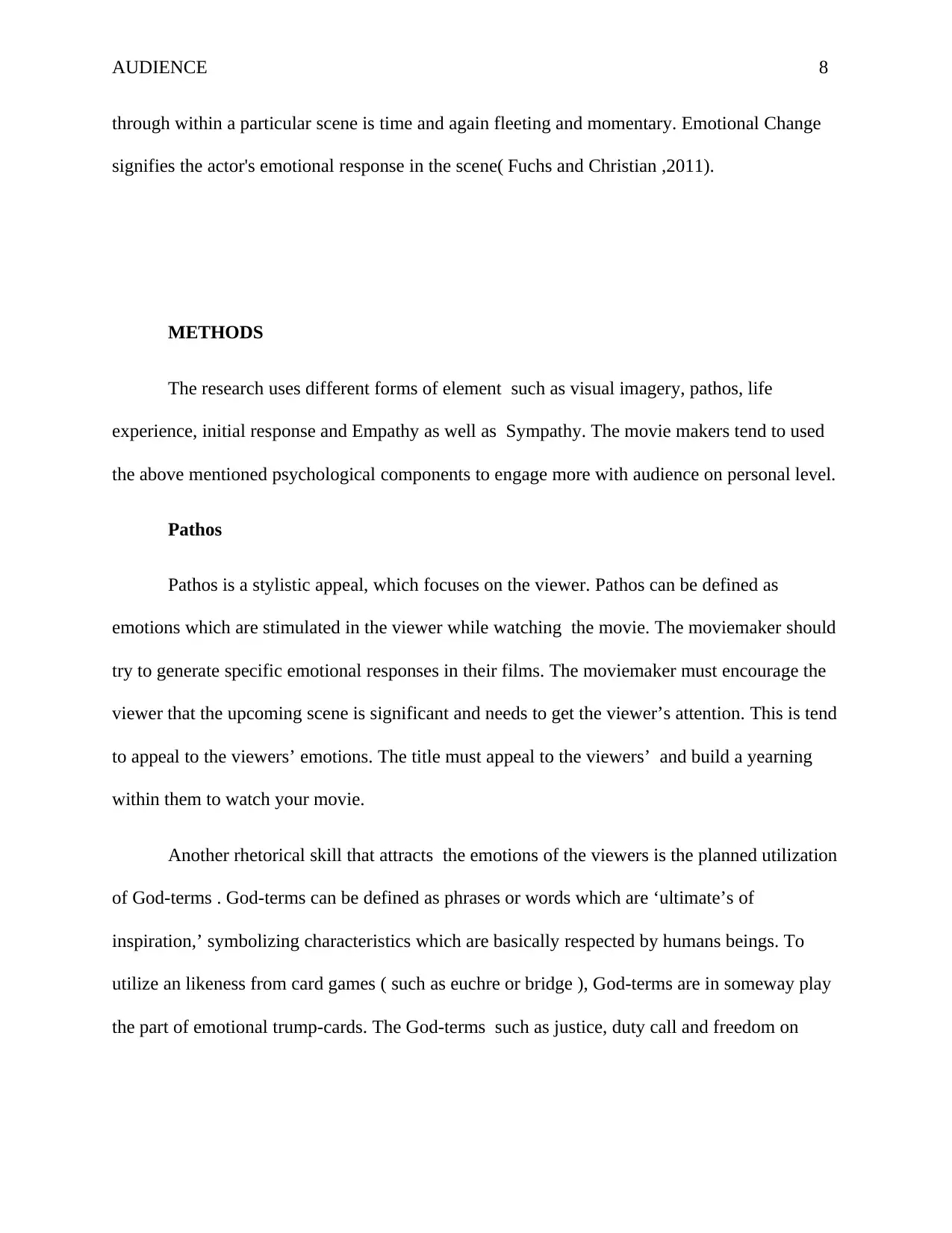
AUDIENCE 8
through within a particular scene is time and again fleeting and momentary. Emotional Change
signifies the actor's emotional response in the scene( Fuchs and Christian ,2011).
METHODS
The research uses different forms of element such as visual imagery, pathos, life
experience, initial response and Empathy as well as Sympathy. The movie makers tend to used
the above mentioned psychological components to engage more with audience on personal level.
Pathos
Pathos is a stylistic appeal, which focuses on the viewer. Pathos can be defined as
emotions which are stimulated in the viewer while watching the movie. The moviemaker should
try to generate specific emotional responses in their films. The moviemaker must encourage the
viewer that the upcoming scene is significant and needs to get the viewer’s attention. This is tend
to appeal to the viewers’ emotions. The title must appeal to the viewers’ and build a yearning
within them to watch your movie.
Another rhetorical skill that attracts the emotions of the viewers is the planned utilization
of God-terms . God-terms can be defined as phrases or words which are ‘ultimate’s of
inspiration,’ symbolizing characteristics which are basically respected by humans beings. To
utilize an likeness from card games ( such as euchre or bridge ), God-terms are in someway play
the part of emotional trump-cards. The God-terms such as justice, duty call and freedom on
through within a particular scene is time and again fleeting and momentary. Emotional Change
signifies the actor's emotional response in the scene( Fuchs and Christian ,2011).
METHODS
The research uses different forms of element such as visual imagery, pathos, life
experience, initial response and Empathy as well as Sympathy. The movie makers tend to used
the above mentioned psychological components to engage more with audience on personal level.
Pathos
Pathos is a stylistic appeal, which focuses on the viewer. Pathos can be defined as
emotions which are stimulated in the viewer while watching the movie. The moviemaker should
try to generate specific emotional responses in their films. The moviemaker must encourage the
viewer that the upcoming scene is significant and needs to get the viewer’s attention. This is tend
to appeal to the viewers’ emotions. The title must appeal to the viewers’ and build a yearning
within them to watch your movie.
Another rhetorical skill that attracts the emotions of the viewers is the planned utilization
of God-terms . God-terms can be defined as phrases or words which are ‘ultimate’s of
inspiration,’ symbolizing characteristics which are basically respected by humans beings. To
utilize an likeness from card games ( such as euchre or bridge ), God-terms are in someway play
the part of emotional trump-cards. The God-terms such as justice, duty call and freedom on
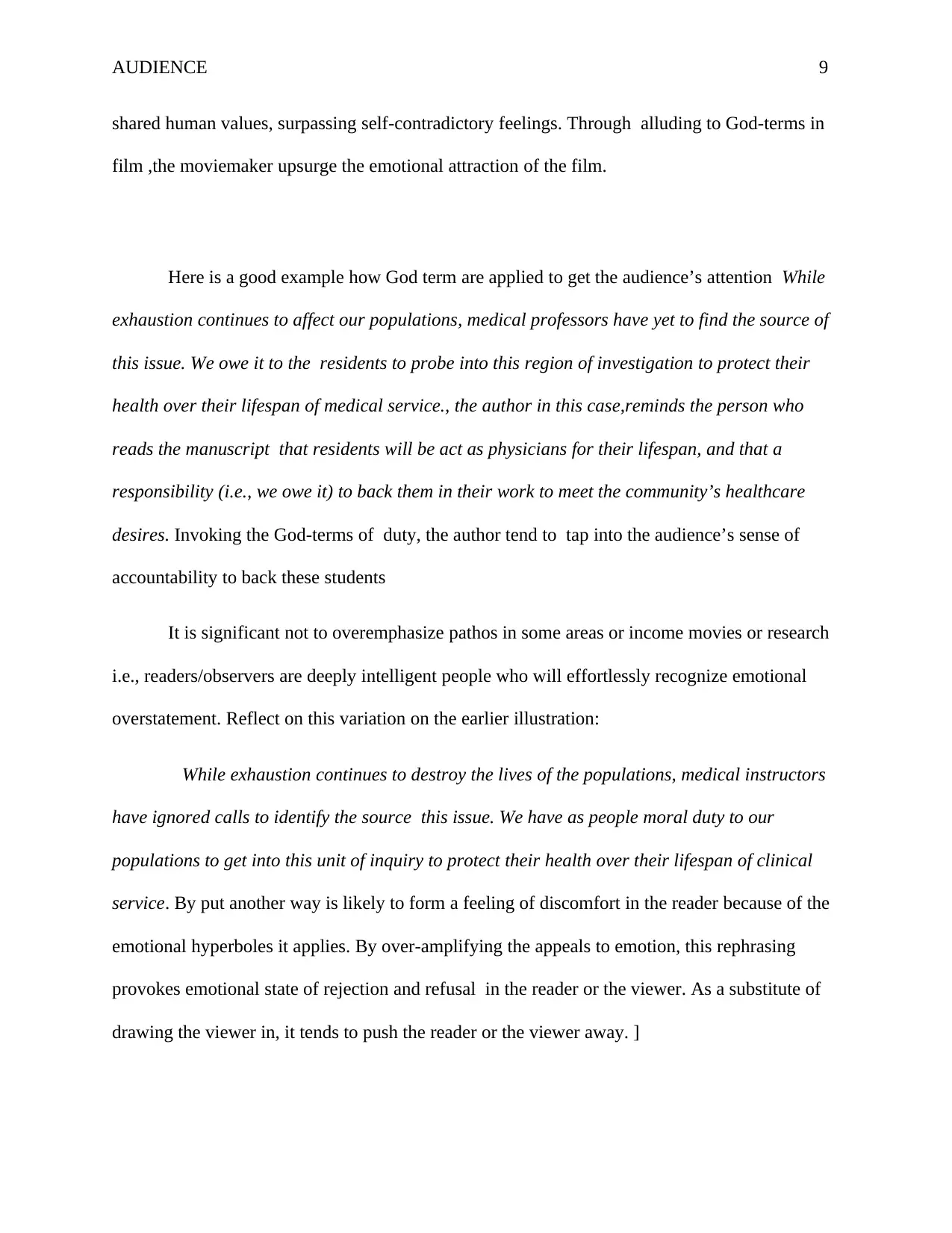
AUDIENCE 9
shared human values, surpassing self-contradictory feelings. Through alluding to God-terms in
film ,the moviemaker upsurge the emotional attraction of the film.
Here is a good example how God term are applied to get the audience’s attention While
exhaustion continues to affect our populations, medical professors have yet to find the source of
this issue. We owe it to the residents to probe into this region of investigation to protect their
health over their lifespan of medical service., the author in this case,reminds the person who
reads the manuscript that residents will be act as physicians for their lifespan, and that a
responsibility (i.e., we owe it) to back them in their work to meet the community’s healthcare
desires. Invoking the God-terms of duty, the author tend to tap into the audience’s sense of
accountability to back these students
It is significant not to overemphasize pathos in some areas or income movies or research
i.e., readers/observers are deeply intelligent people who will effortlessly recognize emotional
overstatement. Reflect on this variation on the earlier illustration:
While exhaustion continues to destroy the lives of the populations, medical instructors
have ignored calls to identify the source this issue. We have as people moral duty to our
populations to get into this unit of inquiry to protect their health over their lifespan of clinical
service. By put another way is likely to form a feeling of discomfort in the reader because of the
emotional hyperboles it applies. By over-amplifying the appeals to emotion, this rephrasing
provokes emotional state of rejection and refusal in the reader or the viewer. As a substitute of
drawing the viewer in, it tends to push the reader or the viewer away. ]
shared human values, surpassing self-contradictory feelings. Through alluding to God-terms in
film ,the moviemaker upsurge the emotional attraction of the film.
Here is a good example how God term are applied to get the audience’s attention While
exhaustion continues to affect our populations, medical professors have yet to find the source of
this issue. We owe it to the residents to probe into this region of investigation to protect their
health over their lifespan of medical service., the author in this case,reminds the person who
reads the manuscript that residents will be act as physicians for their lifespan, and that a
responsibility (i.e., we owe it) to back them in their work to meet the community’s healthcare
desires. Invoking the God-terms of duty, the author tend to tap into the audience’s sense of
accountability to back these students
It is significant not to overemphasize pathos in some areas or income movies or research
i.e., readers/observers are deeply intelligent people who will effortlessly recognize emotional
overstatement. Reflect on this variation on the earlier illustration:
While exhaustion continues to destroy the lives of the populations, medical instructors
have ignored calls to identify the source this issue. We have as people moral duty to our
populations to get into this unit of inquiry to protect their health over their lifespan of clinical
service. By put another way is likely to form a feeling of discomfort in the reader because of the
emotional hyperboles it applies. By over-amplifying the appeals to emotion, this rephrasing
provokes emotional state of rejection and refusal in the reader or the viewer. As a substitute of
drawing the viewer in, it tends to push the reader or the viewer away. ]
⊘ This is a preview!⊘
Do you want full access?
Subscribe today to unlock all pages.

Trusted by 1+ million students worldwide
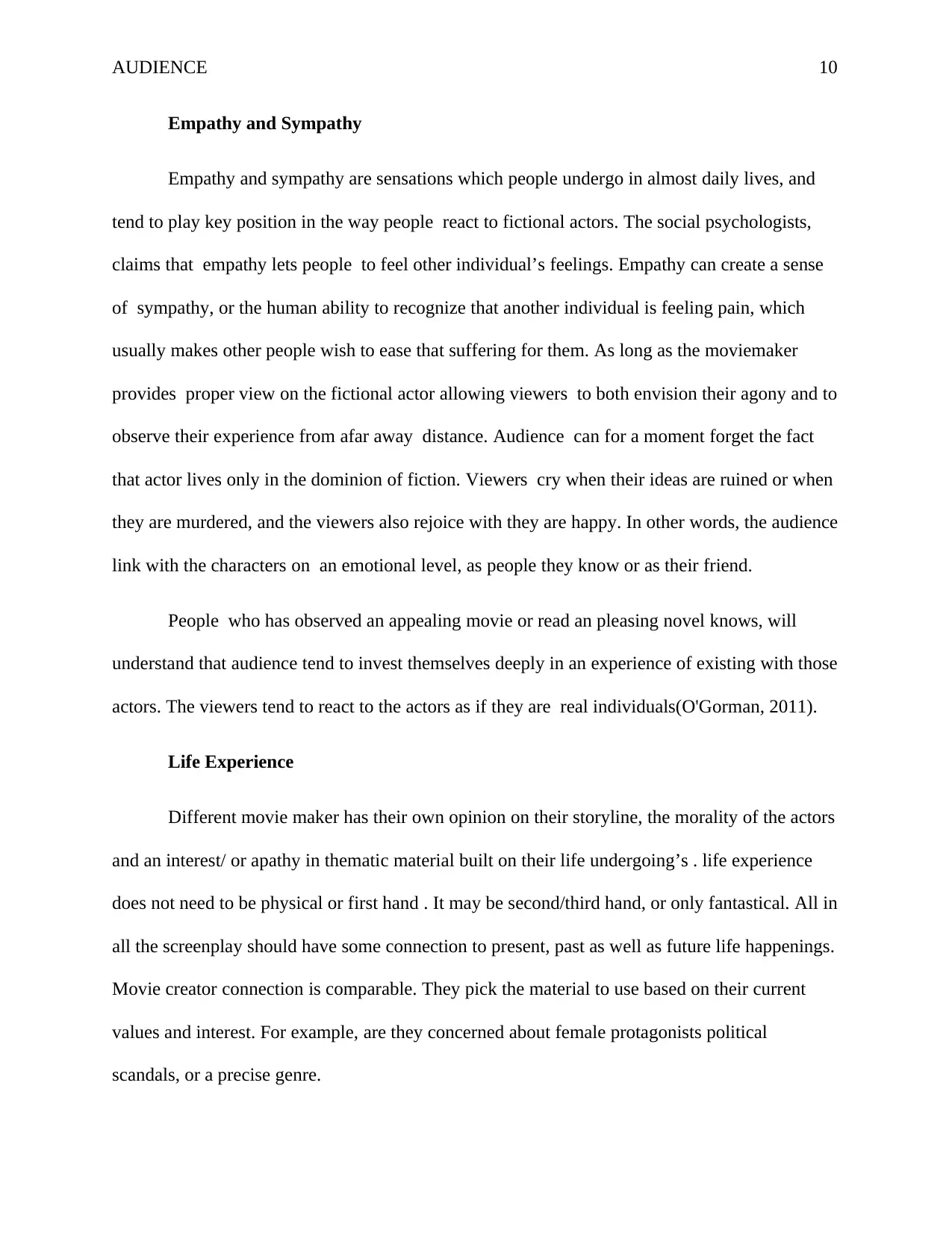
AUDIENCE 10
Empathy and Sympathy
Empathy and sympathy are sensations which people undergo in almost daily lives, and
tend to play key position in the way people react to fictional actors. The social psychologists,
claims that empathy lets people to feel other individual’s feelings. Empathy can create a sense
of sympathy, or the human ability to recognize that another individual is feeling pain, which
usually makes other people wish to ease that suffering for them. As long as the moviemaker
provides proper view on the fictional actor allowing viewers to both envision their agony and to
observe their experience from afar away distance. Audience can for a moment forget the fact
that actor lives only in the dominion of fiction. Viewers cry when their ideas are ruined or when
they are murdered, and the viewers also rejoice with they are happy. In other words, the audience
link with the characters on an emotional level, as people they know or as their friend.
People who has observed an appealing movie or read an pleasing novel knows, will
understand that audience tend to invest themselves deeply in an experience of existing with those
actors. The viewers tend to react to the actors as if they are real individuals(O'Gorman, 2011).
Life Experience
Different movie maker has their own opinion on their storyline, the morality of the actors
and an interest/ or apathy in thematic material built on their life undergoing’s . life experience
does not need to be physical or first hand . It may be second/third hand, or only fantastical. All in
all the screenplay should have some connection to present, past as well as future life happenings.
Movie creator connection is comparable. They pick the material to use based on their current
values and interest. For example, are they concerned about female protagonists political
scandals, or a precise genre.
Empathy and Sympathy
Empathy and sympathy are sensations which people undergo in almost daily lives, and
tend to play key position in the way people react to fictional actors. The social psychologists,
claims that empathy lets people to feel other individual’s feelings. Empathy can create a sense
of sympathy, or the human ability to recognize that another individual is feeling pain, which
usually makes other people wish to ease that suffering for them. As long as the moviemaker
provides proper view on the fictional actor allowing viewers to both envision their agony and to
observe their experience from afar away distance. Audience can for a moment forget the fact
that actor lives only in the dominion of fiction. Viewers cry when their ideas are ruined or when
they are murdered, and the viewers also rejoice with they are happy. In other words, the audience
link with the characters on an emotional level, as people they know or as their friend.
People who has observed an appealing movie or read an pleasing novel knows, will
understand that audience tend to invest themselves deeply in an experience of existing with those
actors. The viewers tend to react to the actors as if they are real individuals(O'Gorman, 2011).
Life Experience
Different movie maker has their own opinion on their storyline, the morality of the actors
and an interest/ or apathy in thematic material built on their life undergoing’s . life experience
does not need to be physical or first hand . It may be second/third hand, or only fantastical. All in
all the screenplay should have some connection to present, past as well as future life happenings.
Movie creator connection is comparable. They pick the material to use based on their current
values and interest. For example, are they concerned about female protagonists political
scandals, or a precise genre.
Paraphrase This Document
Need a fresh take? Get an instant paraphrase of this document with our AI Paraphraser
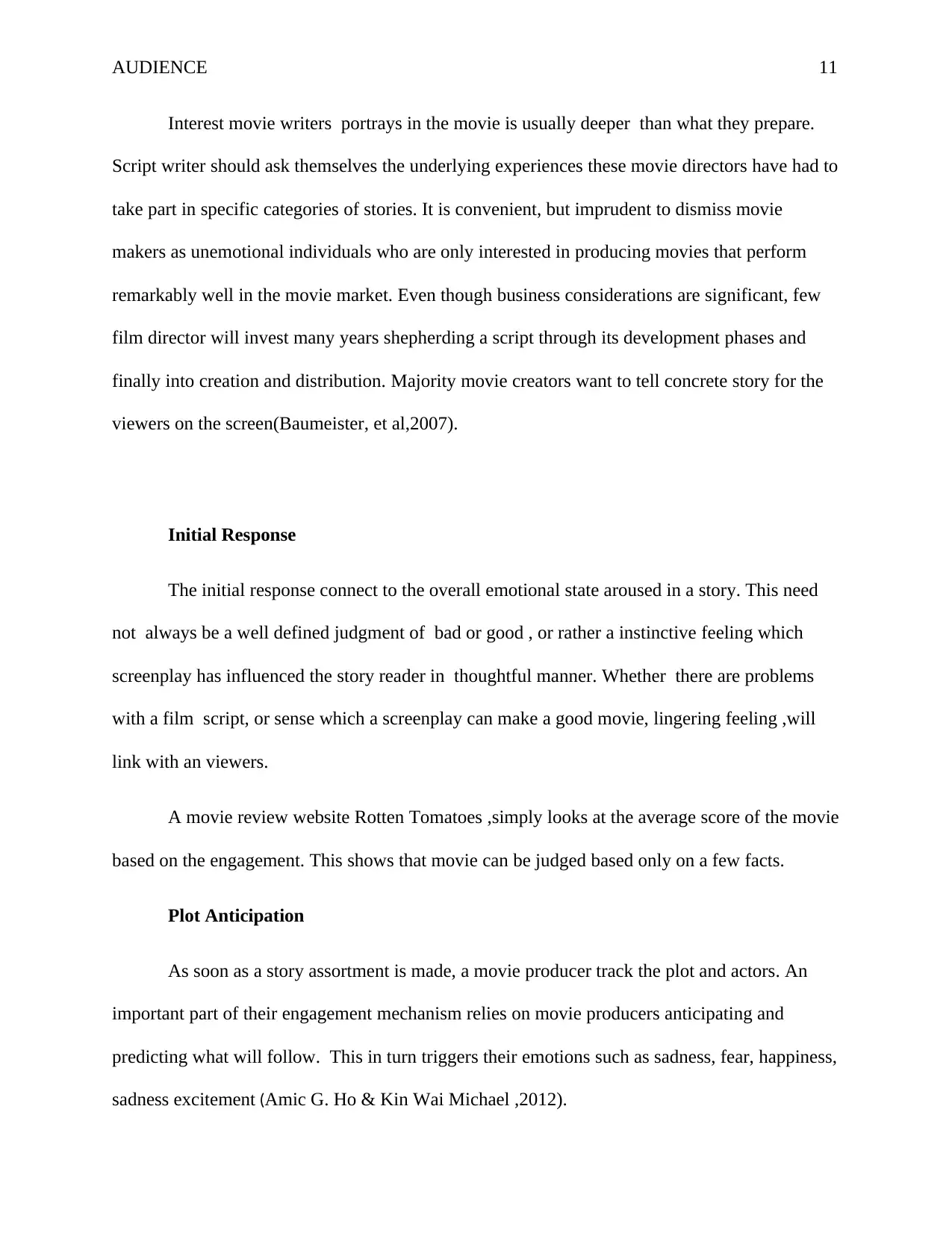
AUDIENCE 11
Interest movie writers portrays in the movie is usually deeper than what they prepare.
Script writer should ask themselves the underlying experiences these movie directors have had to
take part in specific categories of stories. It is convenient, but imprudent to dismiss movie
makers as unemotional individuals who are only interested in producing movies that perform
remarkably well in the movie market. Even though business considerations are significant, few
film director will invest many years shepherding a script through its development phases and
finally into creation and distribution. Majority movie creators want to tell concrete story for the
viewers on the screen(Baumeister, et al,2007).
Initial Response
The initial response connect to the overall emotional state aroused in a story. This need
not always be a well defined judgment of bad or good , or rather a instinctive feeling which
screenplay has influenced the story reader in thoughtful manner. Whether there are problems
with a film script, or sense which a screenplay can make a good movie, lingering feeling ,will
link with an viewers.
A movie review website Rotten Tomatoes ,simply looks at the average score of the movie
based on the engagement. This shows that movie can be judged based only on a few facts.
Plot Anticipation
As soon as a story assortment is made, a movie producer track the plot and actors. An
important part of their engagement mechanism relies on movie producers anticipating and
predicting what will follow. This in turn triggers their emotions such as sadness, fear, happiness,
sadness excitement (Amic G. Ho & Kin Wai Michael ,2012).
Interest movie writers portrays in the movie is usually deeper than what they prepare.
Script writer should ask themselves the underlying experiences these movie directors have had to
take part in specific categories of stories. It is convenient, but imprudent to dismiss movie
makers as unemotional individuals who are only interested in producing movies that perform
remarkably well in the movie market. Even though business considerations are significant, few
film director will invest many years shepherding a script through its development phases and
finally into creation and distribution. Majority movie creators want to tell concrete story for the
viewers on the screen(Baumeister, et al,2007).
Initial Response
The initial response connect to the overall emotional state aroused in a story. This need
not always be a well defined judgment of bad or good , or rather a instinctive feeling which
screenplay has influenced the story reader in thoughtful manner. Whether there are problems
with a film script, or sense which a screenplay can make a good movie, lingering feeling ,will
link with an viewers.
A movie review website Rotten Tomatoes ,simply looks at the average score of the movie
based on the engagement. This shows that movie can be judged based only on a few facts.
Plot Anticipation
As soon as a story assortment is made, a movie producer track the plot and actors. An
important part of their engagement mechanism relies on movie producers anticipating and
predicting what will follow. This in turn triggers their emotions such as sadness, fear, happiness,
sadness excitement (Amic G. Ho & Kin Wai Michael ,2012).
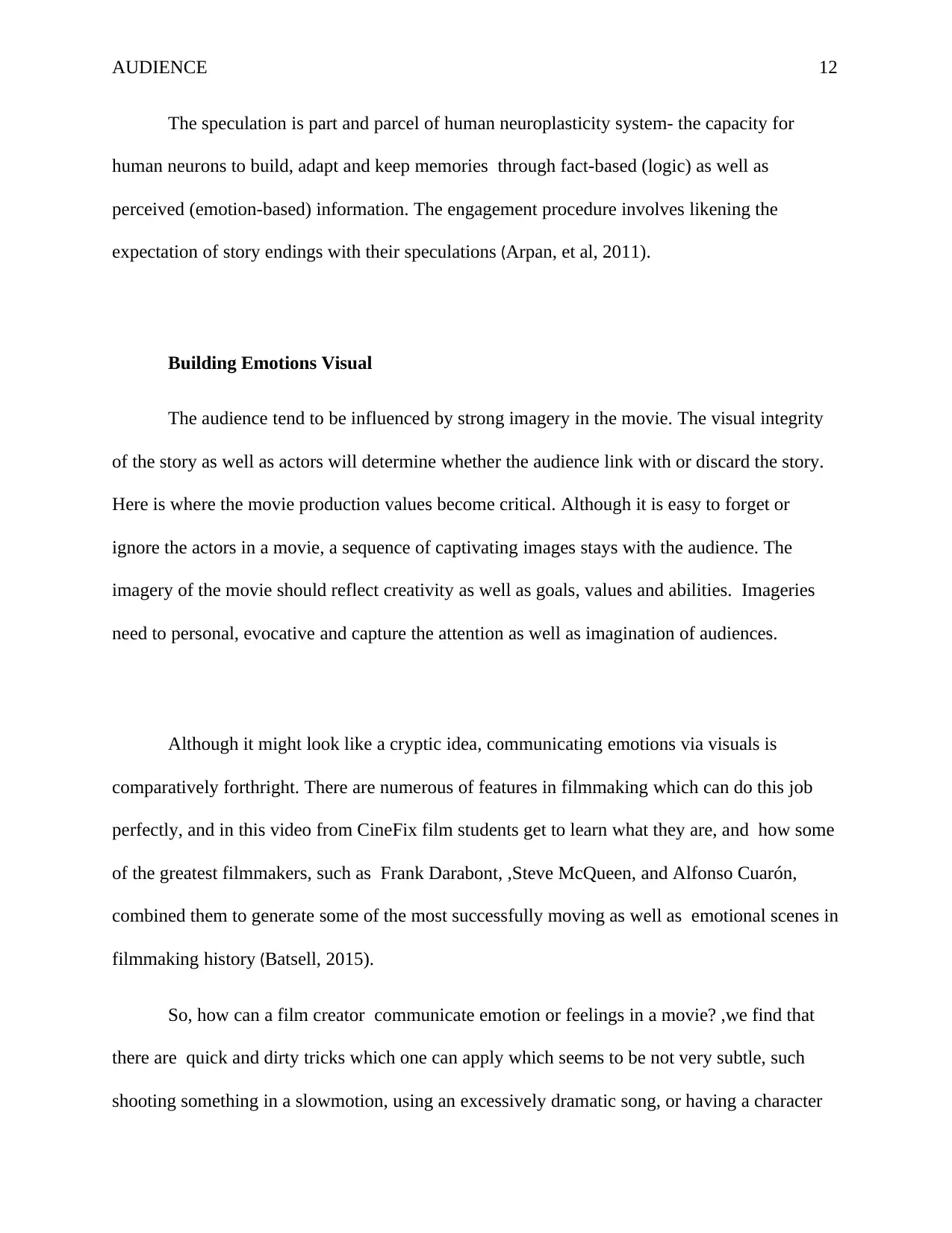
AUDIENCE 12
The speculation is part and parcel of human neuroplasticity system- the capacity for
human neurons to build, adapt and keep memories through fact-based (logic) as well as
perceived (emotion-based) information. The engagement procedure involves likening the
expectation of story endings with their speculations (Arpan, et al, 2011).
Building Emotions Visual
The audience tend to be influenced by strong imagery in the movie. The visual integrity
of the story as well as actors will determine whether the audience link with or discard the story.
Here is where the movie production values become critical. Although it is easy to forget or
ignore the actors in a movie, a sequence of captivating images stays with the audience. The
imagery of the movie should reflect creativity as well as goals, values and abilities. Imageries
need to personal, evocative and capture the attention as well as imagination of audiences.
Although it might look like a cryptic idea, communicating emotions via visuals is
comparatively forthright. There are numerous of features in filmmaking which can do this job
perfectly, and in this video from CineFix film students get to learn what they are, and how some
of the greatest filmmakers, such as Frank Darabont, ,Steve McQueen, and Alfonso Cuarón,
combined them to generate some of the most successfully moving as well as emotional scenes in
filmmaking history (Batsell, 2015).
So, how can a film creator communicate emotion or feelings in a movie? ,we find that
there are quick and dirty tricks which one can apply which seems to be not very subtle, such
shooting something in a slowmotion, using an excessively dramatic song, or having a character
The speculation is part and parcel of human neuroplasticity system- the capacity for
human neurons to build, adapt and keep memories through fact-based (logic) as well as
perceived (emotion-based) information. The engagement procedure involves likening the
expectation of story endings with their speculations (Arpan, et al, 2011).
Building Emotions Visual
The audience tend to be influenced by strong imagery in the movie. The visual integrity
of the story as well as actors will determine whether the audience link with or discard the story.
Here is where the movie production values become critical. Although it is easy to forget or
ignore the actors in a movie, a sequence of captivating images stays with the audience. The
imagery of the movie should reflect creativity as well as goals, values and abilities. Imageries
need to personal, evocative and capture the attention as well as imagination of audiences.
Although it might look like a cryptic idea, communicating emotions via visuals is
comparatively forthright. There are numerous of features in filmmaking which can do this job
perfectly, and in this video from CineFix film students get to learn what they are, and how some
of the greatest filmmakers, such as Frank Darabont, ,Steve McQueen, and Alfonso Cuarón,
combined them to generate some of the most successfully moving as well as emotional scenes in
filmmaking history (Batsell, 2015).
So, how can a film creator communicate emotion or feelings in a movie? ,we find that
there are quick and dirty tricks which one can apply which seems to be not very subtle, such
shooting something in a slowmotion, using an excessively dramatic song, or having a character
⊘ This is a preview!⊘
Do you want full access?
Subscribe today to unlock all pages.

Trusted by 1+ million students worldwide
1 out of 18
Related Documents
Your All-in-One AI-Powered Toolkit for Academic Success.
+13062052269
info@desklib.com
Available 24*7 on WhatsApp / Email
![[object Object]](/_next/static/media/star-bottom.7253800d.svg)
Unlock your academic potential
Copyright © 2020–2025 A2Z Services. All Rights Reserved. Developed and managed by ZUCOL.



